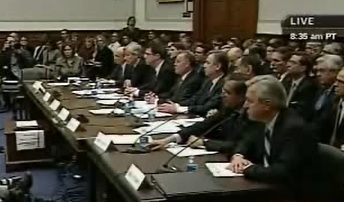Courtesy of Pam Martens
At 8:00 a.m. yesterday, Politico’s Ben White and Aubree Eliza Weaver dropped the news nugget that the nonprofit watchdog, Better Markets, would be releasing one day ahead of today’s House hearing with the CEOs of the largest banks on Wall Street a report titled: “The RAP Sheet for Wall Street’s Biggest Banks’ Crime Spree,” which promised to detail, for the first time, “that of the more than $29 trillion in total bailouts, the six biggest banks in the country (Bank of America, Citigroup, Goldman Sachs, JPMorgan Chase, Morgan Stanley, and Wells Fargo) received more than $8.2 trillion, or nearly one-third of the total bailouts provided to the entire financial system.”
Wall Street On Parade has been reporting since 2012 that of the secret $16 trillion bailout loans made at almost zero interest rates by the Federal Reserve during the financial crisis, a handful of mega banks on Wall Street received the lion’s share. (See here and here.)
But what Better Markets has done in its new report is to combine the Fed’s largess with that of TARP (Troubled Asset Relief Program) and support provided by the Federal Deposit Insurance Corporation and other guarantee programs. It comes up with the following:
“At least $29 trillion was lent, spent, pledged, committed, loaned, guaranteed, and otherwise used or made available to bailout the financial system during the 2008 financial crash. The American people were told that this unprecedented rescue was necessary because, if the gigantic financial institutions, mostly on Wall Street, failed and went bankrupt (like every other unsuccessful private business in America), then they would take down the entire financial system, which would take down the U.S. economy, wreaking havoc on Main Street families.
“This has actually been true since the 1930s for traditional commercial and retail banks, primarily because they provide essential financial services like checking and savings accounts as well as loans to individuals and businesses small, medium, and large. That is the fuel for the American economy, standard of living, and overall prosperity, which is why those banks are insured by the FDIC and backed by the taxpayers. In addition, those banks were guaranteed because the odds of their failure were minimized—and taxpayers were protected—by numerous banking regulators who policed their activities to promote safe and sound banking practices, making bailouts less likely.
…




